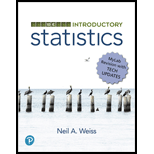
Concept explainers
Recall from Chapter 1 of your text that the Focus Database and Focus sample contain information on the undergraduate students at the University of Wisconsin-Eau Claire (UWEC). Now would be a good time to review the discussion about these data sets. Among the variables considered are the following eight: cumulative GPA (GPA), sex (SEX), high-school percentile (HSP), age (AGE), total earned credits (CREDITS), ACT English score (ENGLISH), ACT math score (MATH), and ACT composite score (COMP). For these database exercises you should use the Focus sample worksheet (FocusSample). Use the technology of your choice to solve the following problems regarding the relationship between the response variable, cumulative GPA, and the seven predictor variables sex, high-school percentile, age, total earned credits, ACT English score, ACT math score, and ACT composite score.
- a. Obtain a
scatterplot matrix of the data for these eight variables. What do these scatterplots tell you about the relationships among the variables? - b. Does a multiple linear regression equation relating cumulative GPA to sex, high-school percentile, age, total earned credits, ACT English score, ACT math score, and ACT composite score seem appropriate for these data? Explain your answer.
- c. Create an indicator variable for sex. If the indicator variable for sex is used in the regression equation, what is the interpretation of its regression coefficient?
- d. Determine the multiple linear regression equation relating cumulative GPA to the indicator variable for sex and the other six predictor variables.
- e. Determine the proportion of variation in the observed cumulative GPAs that can be accounted for by the multiple linear regression equation in the seven predictor variables.
- f. Obtain the variance inflation factor for each predictor variable.
- g. Assess the severity of multicollinearity for this set of predictor variables. Are the t-tests for the utility of the predictor variables adversely affected by multicollinearity for these data?
- h. Use all-subsets regression with Mallows’ Cp criterion to select possible subsets of the predictor variables for predicting cumulative GPA.
- i. Perform a residual analysis for the regression of cumulative GPA on the predictor variables in each subset found in part (h).
- j. Select a final regression model for predicting cumulative GPA.
- k. If you were a university administrator in charge of admissions, would you think that the model you obtained is suitable for predicting cumulative GPA and that it could be used to help select students for admission to the university? Explain your answer.
Want to see the full answer?
Check out a sample textbook solution
Chapter B Solutions
INTRO.STATISTICS,TECH.UPDT.-W/MYSTATLAB
Additional Math Textbook Solutions
APPLIED STAT.IN BUS.+ECONOMICS
Introductory Statistics
Elementary & Intermediate Algebra
College Algebra (Collegiate Math)
Elementary Statistics ( 3rd International Edition ) Isbn:9781260092561
Elementary Statistics: Picturing the World (7th Edition)
 Glencoe Algebra 1, Student Edition, 9780079039897...AlgebraISBN:9780079039897Author:CarterPublisher:McGraw Hill
Glencoe Algebra 1, Student Edition, 9780079039897...AlgebraISBN:9780079039897Author:CarterPublisher:McGraw Hill Holt Mcdougal Larson Pre-algebra: Student Edition...AlgebraISBN:9780547587776Author:HOLT MCDOUGALPublisher:HOLT MCDOUGAL
Holt Mcdougal Larson Pre-algebra: Student Edition...AlgebraISBN:9780547587776Author:HOLT MCDOUGALPublisher:HOLT MCDOUGAL Big Ideas Math A Bridge To Success Algebra 1: Stu...AlgebraISBN:9781680331141Author:HOUGHTON MIFFLIN HARCOURTPublisher:Houghton Mifflin Harcourt
Big Ideas Math A Bridge To Success Algebra 1: Stu...AlgebraISBN:9781680331141Author:HOUGHTON MIFFLIN HARCOURTPublisher:Houghton Mifflin Harcourt


